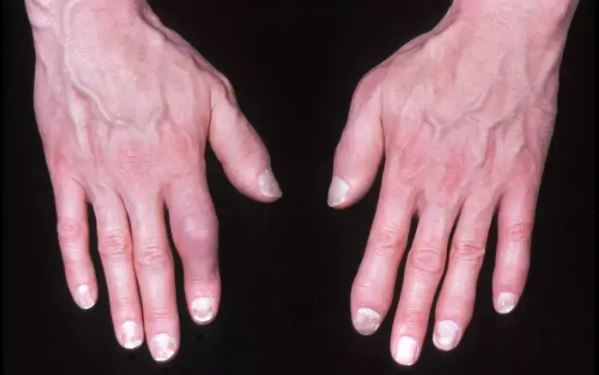You’ve been experiencing pain in your wrists. At first you might chalk it up sleeping funny, or an overuse injury from your yoga class. But if the pain endures, and depending on the specific mix of your symptoms, you may be wondering whether it could it be carpal tunnel, a form of arthritis, or something else.
For some people, however, it’s often not an either-or situation. Having arthritis raises your risk of developing carpal tunnel, so you could have both conditions at the same time.
In this article, we’ll explain why arthritis may be a cause of carpal tunnel and share information about carpal tunnel symptoms, diagnosis, and treatment.
Arthritis vs. Carpal Tunnel Syndrome
While both arthritis and carpal tunnel can affect the wrists, hands, and fingers, the causes for the symptoms differ.
Rheumatoid arthritis is an autoimmune disease, which means your body’s own immune system attacks the joints, causing inflammation, pain, and swelling. Here are other common symptoms of rheumatoid arthritis.
Click Here to Visit the Store and find Much More….
Osteoarthritis is the “wear-and-tear” type that occurs when cartilage that cushions joints wears away. Here are other common osteoarthritis symptoms.
Carpal tunnel syndrome occurs when a major nerve in the hand — the median nerve — becomes compressed in the carpal tunnel, a narrow passageway on the palm side of your wrist that also houses the tendons that bend the fingers.
The floor and sides of this inch-wide tunnel are formed by small wrist bones called carpal bones, which are linked together by a ligament that overlies the top of the carpal tunnel. (The word carpal comes from the Latin “carpus,” which means wrist.)
Repetitive hand motions, such as those that occur when someone works on an assembly line, often contribute to carpal tunnel syndrome. With excessive motion, the tendons of the fingers can get swollen or inflamed and squeeze the median nerve. Despite common thinking that typing causes CTS, even heavy computer use did not make people more likely to develop it, according to one study.
A number of health problems can also cause swelling of this area. Arthritis is one, but diabetes and thyroid issues are also associated with carpal tunnel syndrome, as are hormonal changes that occur during pregnancy. Injuries, such as a wrist fracture, can contribute to the onset of carpal tunnel syndrome.
How Arthritis Can Cause Carpal Tunnel Syndrome
“It’s very common to have carpal tunnel syndrome when you have rheumatoid arthritis, especially if you have rheumatoid arthritis of the wrist,” says Vinicius Domingues, MD, a rheumatologist in Daytona Beach, Florida, and medical advisor for CreakyJoints.
If you have rheumatoid arthritis, chances are it does affect your wrists — research shows they’re the most common site for RA in the upper body and that 75 percent of people with RA have wrist involvement.
Though its impact isn’t usually as great as RA, even osteoarthritis (OA), the wear-and-tear type of arthritis, increases the risk of carpal tunnel too. OA in the wrist can cause swelling and bony changes that crowd the carpal tunnel.
“The wrist is a very small area and if it gets inflamed for any reason, it can cause pressure on the nerve that leads to carpal tunnel syndrome,” says Robert Gotlin, DO, a sports and spine physician in New York City and an associate professor of rehabilitation medicine and orthopedics at the Icahn School of Medicine at Mount Sinai.
Interestingly, carpal tunnel, like rheumatoid arthritis, is three times more likely to affect women than men, possibly because the carpal tunnel itself may be smaller in women than in men. The dominant hand is usually affected first and produces the most severe pain.
Like OA, carpal tunnel is more likely to occur with age; more than three-quarters of people develop symptoms between the ages of 40 and 70.
Luckily, despite some similarities in symptoms between carpal tunnel syndrome and arthritis, doctors usually don’t have much trouble telling the two conditions apart. Even better, there’s some overlap between treatments for both conditions.
Telltale Symptoms of Carpal Tunnel Syndrome
When carpal tunnel develops, it has a typical pattern, says Dr. Gotlin. Some key signs, which can help differentiate carpal tunnel from different kinds of arthritis, include:
1. Numbness and/or tingling in the first three fingers (thumb, index finger, and middle finger)
The median nerve provides sensation to these fingers, as well as to half of the ring finger (the pinky typically isn’t affected). It also provides strength to some of the muscles at the base of the thumb. Initially, numbness and tingling symptoms come and go, but as the condition worsens, they may become chronic.
This may cause you to drop things or leave you unable to perform everyday tasks. “The thumb side of the hand provides precision grip, which is important when you want to do things like use a screwdriver or hold something carefully,” Dr. Gotlin explains. As carpal tunnel progresses, people may say their fingers feel useless or swollen, even though there’s no swelling. In the most severe cases, the muscles at the base of the thumb experience “gross atrophy,” which means they shrink in size.
Click Here to Visit the Store and find Much More….
Carpal tunnel tends to be especially painful at night. Blood pools because your hand isn’t moving, which creates swelling in the wrist. Many people also sleep with their wrists bent, which can also cause more pain at night.
4. ‘Flicking’ provides pain relief
Another tipoff it’s carpal tunnel is that in the early stages, people are usually able to relieve symptoms by shaking their hands rapidly (the “flick sign” in medicalese). “This gets the blood flowing again and reduces swelling, so the pain goes away,” says Dr. Gotlin.
Get more information here about how symptoms of arthritis affect the hands.
How Carpal Tunnel Syndrome Is Diagnosed
Your health care provider can diagnose carpal tunnel by taking a medical history and conducting a physical exam. He or she may tap the inside of your wrist to see if you feel pain or a shocking sensation (the Tinel test) or ask you to bend your wrist down for a minute to see if it causes symptoms (the Phalen test).
Lab tests and X-rays may be used to reveal problems like arthritis, diabetes, and fractures. Your doctor may also employ electromyography (EMG), a test that measures electrical activity of the nerve, to help confirm the carpal tunnel diagnosis.
How Carpal Tunnel Syndrome Is Treated
In most people, carpal tunnel gets worse over time, so early treatment is important. Ignoring symptoms can lead to permanent damage to the nerve and muscles, which can lead to loss of feeling, hand strength, and even the ability to distinguish hot and cold. It may also increase the need for surgery. Luckily, many people get better after first-step treatments, which include:
- Immobilization: Wearing a wrist splint provides support and braces your wrist in a straight, neutral position that takes pressure off the median nerve. A splint can be worn just at night or 24 hours a day.
- Rest: For people with mild carpal tunnel, avoiding activities or taking frequent breaks from repetitive-motion tasks that provoke symptoms may be all you need. If your wrist is red, warm, and swollen, applying cool packs can help.
- Over–the–counter drugs: Nonsteroidal anti-inflammatory drugs (NSAIDS) like ibuprofen may provide short-term relief by calming swelling, but they haven’t been shown to treat CTS itself.
- Prescription medication: In more severe cases, steroid injections are given to relieve pressure on the median nerve. Steroid injections usually aren’t effective in the long term, but research suggests improvement lasts 10 weeks to more than a year. Caution: If you have diabetes, be aware that long-term corticosteroid use can make it hard to regulate insulin levels.
- Alternative therapies: Yoga poses that emphasize opening, stretching, and strengthening the joints of the upper body were shown in one preliminary study to reduce pain and improve grip strength in those with CTS. People in one study who got acupuncture reported improvement in symptoms and functionality. Chiropractic manipulation has also been shown to be beneficial. Be sure to talk with your doctor before trying any of these treatments to be sure they’re appropriate for you.
If you’re diagnosed with both carpal tunnel syndrome and arthritis, the two conditions can be treated at the same time — and sometimes the treatment is even the same. For instance, NSAIDs can help relieve the pain of RA and OA as well as carpal tunnel. The same is true for corticosteroids. In addition to immobilizing the wrist to relieve symptoms of CTS, wearing a splint can provide rest and support for arthritis in the wrist, hand, and fingers.
Click Here to Visit the Store and find Much More….
The Last Resort: Surgery for Carpal Tunnel
When carpal tunnel symptoms are severe and/or don’t respond to these conservative measures, surgery may be required. It’s a very common surgery, performed more than 400,000 times each year.
The outpatient procedure, known as carpal tunnel release surgery, involves making one or more small incisions in the wrist or palm and cutting (“releasing”) the ligament that’s compressing the carpal tunnel to enlarge the area. “It’s no longer a tunnel, but more like a convertible car — the roof is gone,” explains Dr. Gotlin.
Following surgery, the ligaments usually grow back together and allow more space than before. Symptoms are usually relieved immediately after surgery, but full recovery can take up to a year. Recurrence of carpal tunnel following surgery is rare, though, according to Dr. Domingues, it’s more common in people with active rheumatoid arthritis. Be aware that fewer than half of people report that their hand(s) ever feel completely normal post-op. Some residual numbness or weakness is common. Still, it’s comforting to know that the surgery has a high success rate, providing a lasting, good outcome in up to 90 percent of cases in one study.

Click Here to Visit the Store and find Much More….
For More Information Related to Fibromyalgia Visit below sites:
References:
Fibromyalgia Contact Us Directly
Click here to Contact us Directly on Inbox
Official Fibromyalgia Blogs
Click here to Get the latest Chronic illness Updates
Fibromyalgia Stores









